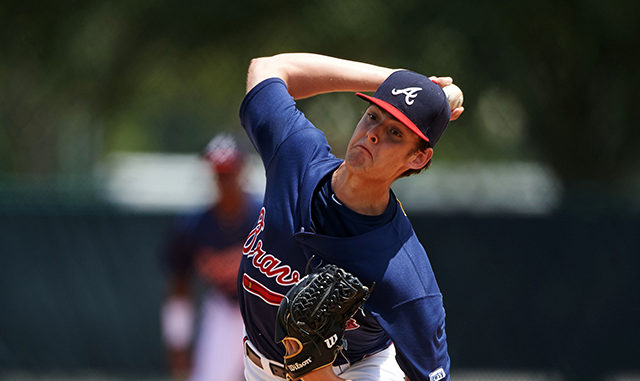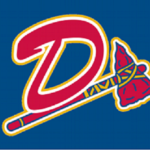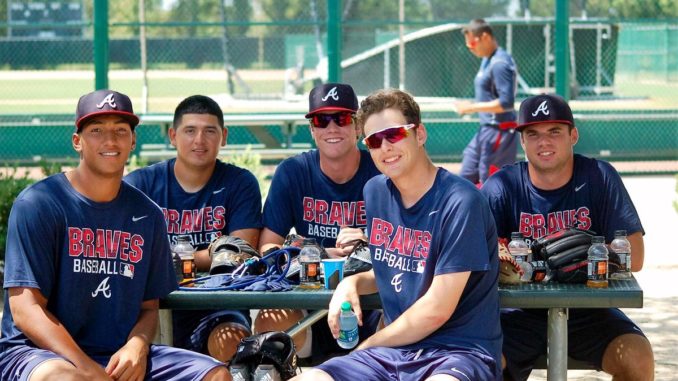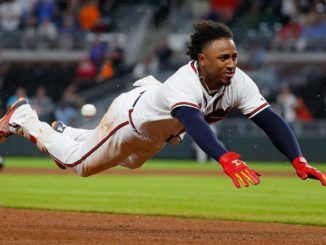
We don’t want a window, we want waves.
-John Coppolella, General Manager of the Atlanta Braves
This is the third and final part of my look at the Braves organizational starting pitching depth, this time focusing on the lower minor league levels, class A Rome and the rookie league Danville Braves. As with the other sections, this level is chock full of high-ceiling prospects, reflecting the work the organization has put in the last two years to bring in high potential arms via the draft, international signings, and trades. Due to the distance most of these pitchers have from the majors, by nature these prospects are riskier, but have just as much potential as the wave of talent now moving through the high-A and AA levels. The pitchers designated Top 30 Prospects have more detailed write-ups in my Get To Know a Prospect series, linked in front of their names for your perusal.
Typically when I have discussed the projected Danville starters I caveat that the results of the 2017 draft will likely have an impact on the roster, and there is no position that is more likely to be true than at pitcher. Call it a guess, but I think the Braves may take a pitcher or two in the draft.

ROME BRAVES (CLASS A)
**TOP 30 PROSPECT** STARTER: Ian Anderson, RHP (Promotion)
The top draft pick by the Braves in the 2016 draft and the third pick overall, Rome fans can look forward to the highest drafted pitcher by Atlanta since Steve Avery in 1988. Already a consensus Top 100 Prospect by ESPN and MLB Pipeline, Anderson will go into his first full pro season with an already solid three-pitch repertoire and good command of all three pitches. He will work on building stamina and working efficiently to maximize the length of his starts.
**TOP 30 PROSPECT** STARTER: Joey Wentz, LHP (Promotion)
The Braves other 1st-round pick from the 2016 draft (40th overall), Wentz also was strong in his pro debut, though a blow-up 1st inning in his first Danville start made his ERA look poor. Like Anderson, Wentz already has a well-developed three-pitch repertoire, and will be looking to sharpen his command and control.
STARTER: Jeremy Walker, RHP (Promotion)
The Braves selected Walker with a 5th-round pick out of Gardner-Webb, carrying on a recent tradition of drafting large-framed pitchers. Walker is listed at 6’ 5” and 220 pounds. The knock on Walker when he was drafted was that while his fastball could tick up into the mid-‘90s, his mechanics were bad. The Braves had some success reclaiming pitchers with this profile, with Patrick Weigel being the latest example of a large-bodied pitcher that worked to clean up bad mechanics and bad habits to become a solid prospect.
Walker made his debut from the bullpen in Danville’s fifth game of the season, and the Braves would use him sparingly through the first four weeks, presumably because they were working on the side on his mechanics. He joined the rotation in August however, and other than a blow-up start on August 25 (6 ER in 3.1 IP), was very good down the stretch. In addition to his fastball, Walker has a good curveball and a developing slider and change-up, and he did a nice job staying around the plate when he moved to the Danville rotation.
STARTER: Drew Harrington, LHP (Promotion)
Harrington was the Braves 3rd-round pick in the June draft this year out of Louisville, where he was the ACC Pitcher of the Year, leading the Cardinals into the NCAA Super Regionals. After working primarily as a reliever his first two years at Louisville, Harrington started 17 games his junior year (including in the playoffs) with a 1.95 ERA. After signing with the Braves, the organization was very careful with Harrington because of his collegiate workload, and was limited to only 14.2 innings. It is unclear if the Braves see Harrington as a starter or reliever going forward. He has a fastball that sits in the low ‘90s with good movement and a big sweeping slider that can generate swing-and-misses. As a starter, Harrington utilized a change-up against right-handers that reportedly has a lot of room for development; if the Braves go the reliever route with Harrington, the change-up could end up getting scrapped.
STARTER: Luis Gamez, RHP (Promotion)
Gamez was a 14th-round pick in the 2014 draft our of Cienega High School near Tuscon, Arizona. Gamez was extremely raw coming out of high school having mostly played the infield and only pitching 15 innings his senior year. The Braves have taken is slow with Gamez as he’s been getting up to speed, and it’s essentially a coin flip now if he will be a starter or a reliever going forward, but he does have an intriguing skillset of a mid-90’s sinker, a credible change-up, and a developing slider. Gamez has had two issues so far in his career, control and staying healthy. At this point, Gamez just needs to get innings if he’s healthy.
BACK-UP: Jaret Hellinger, LHP (Promotion)
BACK-UP: Luis Mora, RHP (Promotion)
BACK-UP: Jhon Martinez, LHP (Promotion)
Much of what I wrote about Gamez can also be said of Jaret Hellinger, a 20th-rounder from Ola High School in McDonough, Georgia. Also very raw coming out of high school, Hellinger has had some success in the rookie league, though control is still an issue. Hellinger is tall and lanky, and he’s had trouble with keeping his release point consistent. Like Gamez, Hellinger has a fastball/change-up combo that can be dominant when he can put the ball where he wants it. Unlike Gamez, Hellinger hasn’t had injury issues and was able to lead Danville in starts and innings pitched.
Mora had one of the more intriguing arms in Danville this past season, with a fastball that clocks into the high ’90s. The issue with Mora is that he can sometimes lose his release point and arm slot which can produce patches of wildness. In between those patches however are stretches of dominance. Mora has a developing slider and also showed a change-up. At age 21 I suspect his future may be as a reliever despite starting in 7 of his 10 appearances in Danville in 2016.
Martinez was another starter in Danville in 2016 that projects as a reliever, but could still grab some starts in Rome. The left-hander throws in the mid-’90s with a max-effort low arm slot that enables him to get good bite and deception on his slider, but makes his release point difficult to replicate, causing occasional control issues. Finishing only two outs behind Hellinger in innings pitched for Danville last season, Martinez may have the stamina, but perhaps not the stuff to stay in a rotation.
 DANVILLE BRAVES (Rookie League)
DANVILLE BRAVES (Rookie League)
**TOP 30 PROSPECT** STARTER: Kyle Muller (Promotion)
Muller is probably the pitcher I am most unsure as to placement. Taken with the 44th pick overall in the 2016 draft, Muller did all that was asked of him in the Gulf Coast League last season, pitching to a 0.67 ERA in 27.2 innings. He has a fastball and a change-up that would probably already be competitive in low-A ball, but it’s clear with his limited workload and lack of a midseason promotion to Danville that the Braves are still working with Muller on some mechanical issues. Given the lack of a midseason promotion, I will conservatively project Muller to start in Danville, but I also would not be surprised at all to see him in Rome before the short season teams starts, similar to how Kolby Allard got a few Rome starts in before going back down to Danville when their season started last year.
**TOP 30 PROSPECT** STARTER: Bryse Wilson (Promotion)
Wilson, the Braves 4th-round pick in 2016, had a similarly dominating 2016 in the Gulf Coast League as Muller in a similar small sample size. Wilson will be tasked with development of a breaking ball to go with his fastball and change-up combo. He’ll also have to avoid distractions from him hometown of Hillsborough, NC, less than a hour south of Danville.
STARTER: Alan Rangel (Promotion)
Rangel was signed out of Mexico before the 2014 season, and has made himself a spot in rookie league rotations because he can throw strikes. This allows his three-pitch repertoire of average pitches to play up at the lower levels. Rangel is entering his age 19 season and at 6′-2″ and 170 pounds there still may be some filling out to do physically, which could in turn help his middlin’ fastball velocity.
STARTER: Odalvi Javier (Promotion)
A late starter out of the Dominican Republic, Javier was signed at the ripe old age of 18. He’s pitched the last two seasons in the Gulf Coast League and did well as both a starter and reliever in 2016. Javier uses a low three-quarters “whipping” delivery that may be more suited to the bullpen, but has good deception and decent fastball movement.
STARTER: Dilmer Mejia (Promotion)
Mejia was only 15 years old when he signed with the Braves out of Nicaragua in the 2013 signing period. Injuries have slowed his development somewhat, but he’s still only 19 going into a likely placement in Danville. Mejia has started and relieved in equal parts, but over the last two seasons he’s pitched much better as a starting pitcher.

FINAL THOUGHTS: Once again, the lower minor league levels for the Braves are projected to be awash with talented pitchers, with Ian Anderson leading the pack of this “second wave”. For high schoolers, the trio of Anderson, Wentz, and Muller are uncommonly polished already. They are also, however, ridiculously young and are about to experience for the first time the grind of full-season baseball. Behind them are two big college picks in Walker and Harrington who will try to emulate 2016’s Patrick Weigel to place their prospect flag in the midst of all the high schoolers. And then there are the true lottery tickets, guys like Wilson, Gamez, Hellinger, Rangel, and Mejia who entered the organization requiring more coaching to get up to speed but also have undeniable talent. Rome had a magical 2016 season, but there’s a possibility that the 2017 squad will reach similar heights, once again lead by high-ceiling starting pitching.
OFR TOP 10 STARTING PITCHING PROSPECT RANKINGS (WITH EXPECTED LEVEL):
- Kolby Allard (A+)
- Mike Soroka (A+)
- Sean Newcomb (AAA)
- Touki Toussaint (A+)
- Max Fried (AA)
- Ian Anderson (A)
- Luiz Gohara (A+)
- Patrick Weigel (AA)
- Lucas Sims (AAA)
- Joey Wentz (A)
Other entries in this series:
Catcher
First Base
Second Base
Third Base
Shortstop
Left Field
Centerfield
Right Field
Starting Pitching, Part 1 (Atlanta/Gwinnett)
Starting Pitching, Part 2 (Mississippi/Florida)




The Walker kid looks great!!!…probably get called up sooner than later.
He’s definitely one to keep an eye on, and one of my picks for a true sleeper in the system. I had the opportunity to watch him Danville once this past season, he pitched in relief and definitely had something about him that stood out, a real competitiveness that shown through.